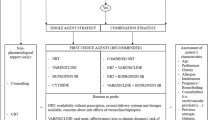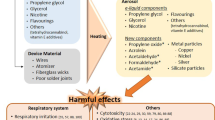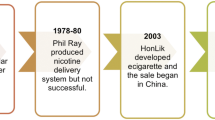Abstract
Introduction
Nicotine replacement therapies (NRT) are effective for smoking cessation. After having received over-the-counter (OTC) status in Germany, concerns grew about effectiveness, increased risks, especially of adverse cardiovascular reactions, and inappropriate use of NRT. Thus, a pharmacy-based cohort study was launched.
Objectives
To assess effectiveness, safety and appropriateness of use of an OTC nicotine patch (Nicotinell, Novartis Ltd.). Every customer who bought an OTC Nicotinell patch was eligible. All data were collected by self-administered questionnaires at weeks 2, 4, 8, 12 and 24 after inclusion. Six hundred and thirty-three customers were admitted, median duration of smoking was 19 years. Of the participants, 6% smoked up to 10 cigarettes per day, 43.6% between 11 and 20, 34.3% between 21 and 30, and 16.1% more than 30 cigarettes. Twenty-four weeks later, 351 participants replied: 28% (177 of 633) had quit smoking completely. Considering replies only the proportion of complete responders raised to 50.4%. There were no serious adverse events reported; 62.9% complied with the directions for use and did not use the patch for more than 3 months. About 45% smoked simultaneously with NRT. Pharmacy-based cohort studies are feasible. This study indicates that the nicotine patch is effective and safe in an OTC setting. There is still room to improve compliance with the directions for use.
Similar content being viewed by others
References
Department of Health and Social Security (1999) Smoking kills—a white paper on tobacco. The Stationary Office, London
Silagy C, Lancaster T, Stead L, Mant D, Fowler G (2001) Nicotine replacement therapy for smoking cessation (Cochrane Review). Cochrane Database Syst Rev 3:CD000146
Lasagna L (1974) A plea for the "naturalistic" study of medicines. Eur J Clin Pharmacol 7:153–154
Heatherton TF, Kozlowski LT, Frecker RC et al (1991) The Fagerström test for nicotine dependence: a revision of the Fagerström Tolerance Questionnaire. Br J Addiction 86:1119–1127
Sinclair HK, Bond CM, Hannaford PC (2001) Long term follow-up studies of users of nonprescription medicines purchased from community pharmacies. Drug Safety 24:929–935
Orleans CT, Resch N, Noll E, et al (1994) Use of transdermal nicotine in a state-level prescription plan for the elderly: a first look at 'real world' patch users. JAMA 271:601–607
Shaw JP, Ferry DG, Damian PB et al (1998) Usage patterns of transdermal nicotine when purchased as a non-prescription medicine from pharmacy. Tob Control 7:161–167
Hughes JR (2001) Commentaries on the effectiveness of over-the-counter nicotine replacement. Drugs Alcohol Rev 20:319–324
Hays JT, Croghan IT, Schroeder DR et al (1999) Over-the-counter nicotine patch therapy for smoking cessation: results from randomized, double-blind, placebo-controlled, and open label trials. Am J Public Health 89:1701–1707
Rumpf H-J, Meyer C, Hapke U, Dilling H, John U (1998) Stadien der Änderungsbereitschaft bei Rauchern in der Allgemeinbevölkerung. Gesundheitswesen 60:592–597
Junge B, Nagel M (1999) Das Rauchverhalten in Deutschland. Gesundheitswesen 61:S121–S125
Tonnesen P, Paoletti P, Gustavsson G et al (1999) Higher dosage nicotine patches increase one-year smoking cessation rates: results from the European CEASE trial. Collaborative European Anti-Smoking Evaluation. European Respiratory Society. Eur Respir J 13:238–246
Balfour D, Benowitz N, Fagerström K et al (2000) Diagnosis and treatment of nicotine dependence with emphasis on nicotine replacement therapy. a status report. Eur Heart J 21:438–445
West R, Hajek P, Foulds J, Nilsson F, May S, Meadows A (2000) A comparison of the abuse liability and dependence potential of nicotine patch, gum, spray and inhaler. Psychopharmacology 149:198–202
Gourlay SG, Forbes A, Marriner T et al (1999) Predictors and timing of adverse experiences during transdermal nicotine therapy. Drug Safety 20:545–555
Joseph AM, Norman SM, Ferry LH et al (1996) The safety of transdermal nicotine as an aid to smoking cessation in patients with cardiac disease. N Engl J Med 335:1792–1799
Kimmel SE, Berlin JA, Miles C et al (2001) Risk of acute first myocardial infarction and use of nicotine patches in a general population. J Am Coll Cardiol 37:1297–1302
Author information
Authors and Affiliations
Corresponding author
Rights and permissions
About this article
Cite this article
Hasford, J., Fagerstrom, K.O. & Haustein, KO. A naturalistic cohort study on effectiveness, safety and usage pattern of an over-the-counter nicotine patch. Eur J Clin Pharmacol 59, 443–447 (2003). https://doi.org/10.1007/s00228-003-0629-8
Received:
Accepted:
Published:
Issue Date:
DOI: https://doi.org/10.1007/s00228-003-0629-8




